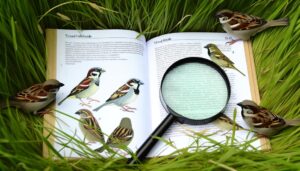What Is the Common Name for Sparrow?
'Sparrow' is a common term referring to small, round-headed birds from the Passeridae family. They're found globally, except in Antarctica, with over 40 species.
Notable ones include the House Sparrow, known for its urban proclivity, and the Song Sparrow, recognized for its melodious calls. These creatures exhibit a robust build and plumage in varied hues of browns and grays.
Sparrows also play a critical role in ecosystems as seed dispersers and insect predators. If one wishes, there's much to explore about their unique adaptations, vibrant male colors, and the essential role they play in the natural world.

Key Takeaways
- Sparrows are small, robust birds belonging to the family Passeridae.
- Common types of sparrows include house sparrows, song sparrows, chipping sparrows, white-throated sparrows, and fox sparrows.
- Each sparrow type has unique features and distinct vocalizations.
- Sparrows are found across all continents, except Antarctica, and adapt to various habitats.
- Sparrows play a crucial role in ecosystems as seed dispersers, insect predators, and contributors to biodiversity.
Understanding the Sparrow Family
To fully appreciate the common sparrow, understanding the intricate dynamics of their family is essential, scientifically known as Passeridae. These birds are characterized by their small size, diverse habitats, and distinct vocalizations.
Sparrows, though often overlooked due to their ubiquity, display a fascinating complexity in their social structures and mating behaviors. They're often territorial, with males fiercely defending their nesting sites. Sparrows are also monogamous, and both parents contribute to the feeding and care of their fledglings.
Contrary to popular belief, sparrows aren't just city dwellers. They've adapted to a variety of environments, from urban areas to farmlands and forests. Their vocalizations, though not melodious, serve vital communication purposes, such as mating calls and alarm signals.
Common Types of Sparrows
Diving into the world of sparrows, you'll encounter a variety of common species, each with unique characteristics and behaviors worth noting.
The House Sparrow, for instance, is a robust, widespread species, often found in urban environments.
Equally common is the Song Sparrow, distinguishable by its melodious call.
The Chipping Sparrow, named for its sharp, chip-like song, prefers woodland edges, while White-throated Sparrows, identified by their distinctive head markings, favor forests and thickets.
Fox Sparrows, recognized by their rufous color and spotted underparts, are typically woodland dwellers.
Finally, the diminutive Savannah Sparrow, a grassland species, often nests in fields and prairies.
Each type reflects a unique adaptation to different habitats, showcasing the remarkable versatility of sparrows.
Sparrow Identification and Characteristics
How can one identify a sparrow among the multitude of bird species? Sparrows present several defining characteristics that aid in their identification. Small but robust, most sparrows have a stout build, with a round head and short tail. They possess strong, conical beaks designed for seed eating, a reflection of their dietary preferences.
Their plumage, often a mix of browns and grays, is typically muted but can display subtle variances. Male sparrows occasionally sport more vibrant colors or distinctive markings, especially during the breeding season. Sparrows also have a unique song and chirp, which can be used for identification.
Though there are variations across different species, these characteristics provide a general guide to identifying sparrows, a common but often overlooked bird.
Sparrow Habitats and Distribution
While identification of sparrows can be done through their physical characteristics and unique songs, understanding their habitats and distribution patterns provides a broader perspective on these birds' global presence. Sparrows are found across all continents, except Antarctica. They're adaptable and thrive in diverse environments, from urban areas to remote countryside and forests.
A study shows that their distribution isn't random but rather influenced by food availability, presence of predators, and nesting sites. Sparrows favor habitats with abundant grasses and shrubs, where seeds and insects, their primary food sources, are plentiful. They're also known to be sedentary, meaning most species stay within their chosen habitat throughout their lives.
This adaptability and sedentariness have contributed to their widespread distribution.
Importance of Sparrows in Ecosystem
Sparrows play an important role in the ecosystem, acting as efficient seed dispersers and insect predators, maintaining a balance in plant growth and insect populations. By consuming seeds, they contribute to the spread of various plant species, aiding in biodiversity.
Their feeding on insects helps control the population of potentially harmful bugs, playing a vital role in pest management. They're also a food source for larger predators, forming an essential link in the food chain.
Additionally, their nests provide spaces for other species, enhancing habitat diversity. Sadly, their numbers are declining due to habitat loss and pollution. Protecting sparrows, thus, isn't just about preserving a species, but ensuring the stability of ecosystems they inhabit.
Conclusion
Sparrows, often overlooked due to their commonplace presence, play a pivotal role in our ecosystem. These tiny birds, varying from house sparrows to song sparrows, have adapted to diverse habitats worldwide.
Their intricate behaviors and distinctive characteristics make them fascinating subjects of study. Their essential role in seed dispersal and pest control illustrates the interconnectedness of nature.
Hence, understanding the humble sparrow is essential to appreciating the complexity and balance of our world's ecosystems.






